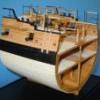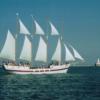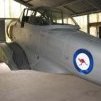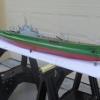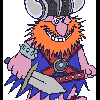Supplies of the Ship Modeler's Handbook are running out. Get your copy NOW before they are gone! Click on photo to order.
×
-
Posts
2,418 -
Joined
-
Last visited
Reputation Activity
-
 dvm27 got a reaction from botra288 in Speedwell 1752 by dvm27 (Greg Herbert) - FINISHED - Ketch Rigged Sloop
dvm27 got a reaction from botra288 in Speedwell 1752 by dvm27 (Greg Herbert) - FINISHED - Ketch Rigged Sloop
Bollard and Hawse Timbers
Thanks, all for your kind comments. A bit of serendipity with regards to the crash - many of us are putting up more photos than the first version. The ease of posting them and lack of file size restrictions make it a breeze.
The bollard and hawse timbers are among the most challenging to make on the model. As well, they are the first timbers made after the keel, and the learning curve hasn't had a chance to kick in yet. So it's important to take your time getting them right and redo them if necessary (as Ed T. has also pointed out in his excellent log). The last little filler piece has no real pattern. It's just cut over-sized and "massaged" into place.
The last photo illustrates the rather diminutive size of Speedwell as compared to an earlier discarded attempt at my Swan class model. The sixth rate looks gigantic compared to Speedwell. Yet they wood both look like longboats compared to a third rate or larger!
-
 dvm27 got a reaction from mtaylor in Sultana by CharlieZardoz - Model Shipways - 1:64
dvm27 got a reaction from mtaylor in Sultana by CharlieZardoz - Model Shipways - 1:64
Enjoy your log Charlie. You know, I believe accurately shaping a solid, machine caved hull is much more difficult than building a plank on bulkhead model.
-
 dvm27 got a reaction from Landrotten Highlander in Le Fleuron 1729 by rekon54 - 1:24
dvm27 got a reaction from Landrotten Highlander in Le Fleuron 1729 by rekon54 - 1:24
Love the detail under the hinged pillars where the deck is slope-mortised to allow them to fully extend. Never seen anything like this before but it makes perfect sense.
Could you describe how you created the flange detail of the hawse tubes?
-
 dvm27 got a reaction from Elijah in Sultana by CharlieZardoz - Model Shipways - 1:64
dvm27 got a reaction from Elijah in Sultana by CharlieZardoz - Model Shipways - 1:64
Enjoy your log Charlie. You know, I believe accurately shaping a solid, machine caved hull is much more difficult than building a plank on bulkhead model.
-
 dvm27 got a reaction from PeteB in Young America 1853 by EdT - FINISHED - extreme clipper
dvm27 got a reaction from PeteB in Young America 1853 by EdT - FINISHED - extreme clipper
Brilliant, Ed. Even with your explanation I had to spend some time figuring how you went from photo one to two!
-
 dvm27 reacted to druxey in Greenwich Hospital barge of 1832 by druxey - FINISHED - 1:48 scale
dvm27 reacted to druxey in Greenwich Hospital barge of 1832 by druxey - FINISHED - 1:48 scale
That's correct, Joel - I hope! The last clinker boat I built was done this way. It's amazing how clinker planking holds the boat's shape. I even took the boat off the plug when half-planked to demonstrate. The frames will be bent in later on in the process.
-
 dvm27 reacted to druxey in Greenwich Hospital barge of 1832 by druxey - FINISHED - 1:48 scale
dvm27 reacted to druxey in Greenwich Hospital barge of 1832 by druxey - FINISHED - 1:48 scale
A small update: Before waxing the plug, I drew in the overlaps of the clinker planking. I made them 1" wide and are seen as dashed lines on the plug. Two coats of Clapham's beeswax polish were used over the mark-out.
Leaves of ¾" thick Castello have now been prepared for the planking. They were cut a little over-thick and then taken down almost to spec on a thickness sander. Finer grades of sandpaper on sanding blocks produced a smooth surface. Hopefully there will be time to commence planking soon.
-
 dvm27 reacted to druxey in HMS Vulture 1776 by Dan Vadas - FINISHED - 1:48 scale - cross-section - from TFFM books
dvm27 reacted to druxey in HMS Vulture 1776 by Dan Vadas - FINISHED - 1:48 scale - cross-section - from TFFM books
After the full model, you should be able to do the deck framing in your sleep, Dan! Looking good.
-
 dvm27 reacted to Dan Vadas in HMS Vulture 1776 by Dan Vadas - FINISHED - 1:48 scale - cross-section - from TFFM books
dvm27 reacted to Dan Vadas in HMS Vulture 1776 by Dan Vadas - FINISHED - 1:48 scale - cross-section - from TFFM books
..... continued.
An interesting little piece of "iron" work is a pair of Iron Knees, used to brace the Beam Arms. The pics should be self-explanatory :
Danny
-
 dvm27 reacted to Dan Vadas in HMS Vulture 1776 by Dan Vadas - FINISHED - 1:48 scale - cross-section - from TFFM books
dvm27 reacted to Dan Vadas in HMS Vulture 1776 by Dan Vadas - FINISHED - 1:48 scale - cross-section - from TFFM books
A pic I forgot to add in the last update - the Limber Boards, which cover the limber channels to stop them from getting blocked with ballast etc :
Now the well is finished it's time to do the lower deck framing, starting with the Hanging Knees. There are only 6 to make for each deck. These need to be individually shaped to fit the internal timbers, even in this relatively straight section of the hull :
The Lodging Knees are of varying shapes and sizes. This is the only one that would be the same as in the rest of the ship :
At the Deadflat, which is one frame aft of the forward part of this model, is a pair of Opposed Lodging Knees. The hanging knees in the forward part of the ship are forward of the beams, whilst those in the after part of the ship are behind them. Therefore the need for a transition from fore to aft with the lodging knees. Because of the area I'm using for the cross-section I can only show half of the forward (upper) knee :
Next come the Carlings, the longitudinal framing timbers. These are of various widths, depending on their functions. The "standard" ones are 6" wide, those alongside the hatches are 7 1/2". I've notched all the carlings for the Ledges, some of which are already fitted :
Continued in next post .....
-
 dvm27 got a reaction from mtaylor in Le Fleuron 1729 by rekon54 - 1:24
dvm27 got a reaction from mtaylor in Le Fleuron 1729 by rekon54 - 1:24
Love the detail under the hinged pillars where the deck is slope-mortised to allow them to fully extend. Never seen anything like this before but it makes perfect sense.
Could you describe how you created the flange detail of the hawse tubes?
-
 dvm27 got a reaction from Altduck in A new video about making gun carriages
dvm27 got a reaction from Altduck in A new video about making gun carriages
Great video, Jay. Two small tips for novice machinists:
1. If you want to turn wood down to a very small diameter use an oversized piece of wood in the headstock and only work on small lengths (perhaps 1") at a time. The minimizes deflection.
2. When parting off small, repetitive pieces with a drilled out center (such as cannon wheels) insert a length of thin wire down the center with plenty of overhang. The wheel will stay on the wire when parted as opposed to flying across the workshop.
-
 dvm27 got a reaction from RichardG in A new video about making gun carriages
dvm27 got a reaction from RichardG in A new video about making gun carriages
Great video, Jay. Two small tips for novice machinists:
1. If you want to turn wood down to a very small diameter use an oversized piece of wood in the headstock and only work on small lengths (perhaps 1") at a time. The minimizes deflection.
2. When parting off small, repetitive pieces with a drilled out center (such as cannon wheels) insert a length of thin wire down the center with plenty of overhang. The wheel will stay on the wire when parted as opposed to flying across the workshop.
-
 dvm27 reacted to Fam in Le Colibri 1808 by Fam - scale 1:48 - POB French brick de 24
dvm27 reacted to Fam in Le Colibri 1808 by Fam - scale 1:48 - POB French brick de 24
February 1st, 2016
Hi all
here I am with a new small update for my French Brig “Le Colibri”. It was a busy 2 weeks period, as the stern windows are very time consuming due to their very small size... but let’s start with order.
The first job I started with was the finishing of the transom. It consisted of two phases, the planking and the application of 4 moldings.
For the planking I used the same 0.5mm Tanganika veneer as for the main hull. In this case the planks layout is clearly depicted in the Ancre monography, so I quickly copied the plans and pasted the templates to the veneer.
Before gluing the planks I had to draw the horseshoe profile in the uppermost part of the transom face, and the profile for the large molding in its lower part. Then the planks application started.
After planking, the two round gunports where cut out and filed flush to their lining.
I then installed the first of the two moldings delimiting the area where some decorations are scheduled: this is built with a 2x1mm Pearwood strip bent with water and heat. The strip is sitting on the planks thickness, which greatly helps both shaping and gluing.
2mm width is much more than the amount required, as the molding only needs to be raised less than 1mm from the planked surface of the transom: it will be trimmed later.
Second phase, I added another Pearwood strip to the rearmost upper edge of the transom. This is 3mm wide, as the extra 1mm is needed to glue the molding above the transom: this way, this will also be the aft molding for the transom upper border that will contain some other decorations.
And finally a third 1x1mm strip is glued to the forward-most edge of the transom upper border, thus enclosing the second recessed area for the stern decorations.
As already said all these strips have excess of material: after glue was set, they were sanded with a rotating abrasive disk down to the required width and thickness.
BTW, I will never stop being amazed by the ease of bending this wood with just some heat, it’s unbelievable! Consider that I had to bend them in horseshoe shape and then edgewise to match the transom profile when seen from above, all in a single piece!!
Second task: the galleries.
Well, some of their parts are already visible in the above pictures, because I worked in parallel on multiple items while waiting for the glue to set. This was the sequence:
The profile of the side galleries, or fake windows as you prefer, is given in the plans. So again I just copied, mirrored and pasted it to both sides to draw the involved profiles.
With them defined, I could remove with a scalpel the portions of the three side moldings affected by the galleries:
Next I draw from the plans the floor and ceiling profiles for the windows area and transferred them to a thin plywood sheet: 2mm thick for the floor where a wide decorative molding is scheduled, 1mm thick for the ceiling where the molding is narrower.
Vertical positioning of the two profiles was quite tricky, as I had to match their slope (when seen from the side), the matcing surface of the transom wings, the large side molding of the hull and the multiple sheaves block.
In the end I realized that the only way to get the correct orientation was to fit the floor profile below the transom wings, and not just forward of them. So in the above picture the port floor profile is correctly shown in its final position, while the following picture shows the starboard side with the incorrect positioning. The starboard profiles were only temporarily glued, so I easily managed to remove both of them, rebuild a longer floor profile and reinstall them.
As far as the ceiling profile, its rear side is too high and touches the sheaves block with its internal corner: I had to lower it about 1mm at the rear to get the correct slope (seen from the side) and to clear the block with the required distance.
Windows then: a real pain in the ...! They are so small and tiny that I found no alternative other than building them one by one by hands: no automatization was possible, nor it was worth, because they are not equal to each other and they are just six.
So I cut very thin strips for the contour and the internal frame, using two qualities of Pearwood: 0.8mm thick darker Pearwood for the borders, 0.5mm light Pearwood for the frame pieces. Width (i.e. the window thickness) is 2mm for both and is reduced to 1mm after mounting is completed.
This is the first prototype almost completed: it took a whole building session of three hours to get at this stage!!
And this is the completed prototype, thinned and sanded, compared to the plans: measures are something about 12x7mm, with backward sloping tenon junctions at all corners.
I was satisfied with the result, so started with ‘mass’ production. The pillars are 2.7mm wide, and I chose a slightly different decoration with respect to the plans that, I remind, deal with the Le Cygne brig.
Another consideration about the general layout of the stern galleries: in all the plans of the Le Cygne class brigs we managed to find (with ‘we’ I’m meaning JA and myself), there are apparently only two layouts that only differ in the shape of the upper roof. The brig Le Cyclope, which pictures were posted by JA in his buildlog here (http://modelshipworld.com/index.php/topic/7795-hms-guadeloupe-ex-french-le-nisus-brick-de-24-by-jackaubrey-148-scale/?p=242287), shows the second possible layout.
Given the total absence of any drawing (so far) for Le Colibri, I decided to stick with the plans.
The following is another picture of the starboard gallery at a later stage: the glass, or blind, of the fake windows is simulated by gluing a piece of clear plastic sheet to the back of the window structure. I sanded the front surface of the plastic with very fine (1000 grade) sanding paper to diminish its glossy look, ant then painted black its back side.
The port windows and pillars completed: a simple capital is still missing from both ends of the pillars, but the basic shape is complete.
Now the upper roof: I took advantage of the skill learned while making the bow cheeks, because even in this case it was just a matter of matching multiple surfaces.
This is the starting point, with a block of Basswood cut and sanded to match the hull (on the internal side) and the front face of the transom wing (on the back face).
Then the external profile is vertically cut just matching the border of the windows ceiling profile. Also the forward slope is roughly cut, using the profile line draught on the hull side:
Next the forward slope is refined, until getting the correct shape, and the upper face is cut following the line draught on the hull:
Finally the inside part is cut, removing the material blocking the sheaves block:
And this is the roof piece sanded smooth, sealed, sanded again and painted matt black:
Note that also the recessed area for the transom border decoration has been painted, in preparation for the next stage.
The final look of the port gallery, with the required decorative moldings applied to the roof. A floral decoration is still needed on the roof surface; I have to figure out how to build one sufficiently thin and delicate for my taste. A paper template for the transom border decoration is also evident.
As all these jobs were quite demanding, I needed something alternative to relax. So switched back to the bow area and started preparing the pieces for the catheads.
First step was to cut the recesses in the gunwales that are needed to house the cathead beam.
I prepared a template showing the beams angle as seen from above, and positioned it on the hull centerline and, in the longitudinal axis, using the only reference body that I have already available: the bitt for the bowsprit foot.
After cutting the two recesses in the gunwales, I could start with the inner beam: Cherrywood was the choice this time, to match the color I’ve decided for all the deck fittings. I started removing a portion of molding and then shaped the face matching the inside bulwark and the waterway. My scope was to get a tight fit without cutting the waterway, so took my time and adapted the lower surface with continuous test fits and modifications.
For the outward side, I had to build a simple jib permitting to obtain the correct cathead angle in the horizontal and vertical plane. The vertical knee is just a dummy for the final knee, whose shape is available in the Ancre plans. The horizontal knee is just a piece of wood cut to the correct angle, with respect to the outboard surface of the bulwark, and resting under the protruding gunwale. To obtain the correct horizontal angle, i.e. with the cathead slightly backward of the perpendicular to the bulwark, I used again the template above shown.
Also visible is the upper portion of the inner vertical beam, that I left longer than needed.
Last picture related to the cathead shows the completed starboard item. To reach this stage I deepened and sloped the gunwale recess and cut the internal beam flush with the recess, so that the athwart beam could be positioned with the correct angles. Then glued the two beams together, strengthening the joint with a brass pin that will remain invisible. Then completed the job with filing and sanding until getting the final shape.
Were the catheads of this type built in a single piece, or by joining two beams the way I did? And in the latter case, was any metalwork visible for the junction of the two pieces? I don’t know, I’ve seen examples of both types... any suggestion?
Last job I did, again to ‘relax’ among more demanding works, was to start carving the transom decorations.
I evaluated different types of decoration suitable to fill the narrow strip on the transom border, and even considering that the same decoration would have to be used for the slightly larger area on the back face of the transom. I considered simple disks, shells, leaves, had a look in my photographic database of shipmodels...then decided for a sequence of overlapping stylized leaves: leaves and flowers should match the typical environment where hummingbirds (= colibri) live, it looked like a good and logic choice.
This is the start of the task, from a 3.2x1mm strip of dark Pearwood. The pencil gives an idea of proportions.
The shown rotary tools are my best friends for this type of carvings: I got them from my dentist, as a present after hours of pain and thousands of Euros
The two missing tools in above picture are a very sharp cutter blade and a chisel I build from a screwdriver... less than 1mm wide, good handle, very hard steel that keeps quite well the cutting edge.
The next picture shows the first strip completed and the next ready to start. The completed decoration has been already bent in two directions and twisted to conform the composite shape of the transom border: the carving makes its easier, together with water soak and heat, but Pearwood is just...
And this final picture shows the starboard gallery as it was yesterday evening
Regards
Fam
-
 dvm27 reacted to GLakie in Tool for Shaping Brass Strip
dvm27 reacted to GLakie in Tool for Shaping Brass Strip
That's where having a vise or anvil would come in handy!
-
 dvm27 reacted to michael mott in Herreshoff Buzzards Bay 14 by michael mott - 1:8 scale - SMALL
dvm27 reacted to michael mott in Herreshoff Buzzards Bay 14 by michael mott - 1:8 scale - SMALL
Thank you all for the kind remarks and feedback.
build part 24
I am going to keep the interior as contrasting varnished woods regarding the benches floorboards and coamings and decks
The forward bulkhead and the lazaret will be the Costello and the floorboard are redwood as will be the seats the coaming will be mahogany and the deck planks Costello with a mahogany toe rail.
I will make the floorboards removable with some sort of brass (bronze ) fixings.
Michael
-
 dvm27 reacted to michael mott in Surabaya by Piet - 1/80 - Mid 17th-Century VOC ship
dvm27 reacted to michael mott in Surabaya by Piet - 1/80 - Mid 17th-Century VOC ship
Piet, pity about the broken drill bit, did it break just as it was about to come through? if that was the case it might have been because the drill has to be modified a little to drill through brass. so that it does not grab. With brass the tip needs to be toughed with a stone to put a tiny flat so that the drill bit is prevented from digging in as it cuts. Also some brass is gummy and does not machine well.
Michael
-
 dvm27 got a reaction from Piet in Young America 1853 by EdT - FINISHED - extreme clipper
dvm27 got a reaction from Piet in Young America 1853 by EdT - FINISHED - extreme clipper
Brilliant, Ed. I would have thought that forming the spokes and adding them later would have been the way to go but your method is both simple and elegant. Were there any issues with deflection of the disk while machining the spokes and boring the holes? Doesn't seem like a lot of contact between the jaws and the disk.
-
 dvm27 got a reaction from robin b in HMS Dragon 1760 by Siggi52 - FINISHED - Scale 1:48 - English 74-Gun ship
dvm27 got a reaction from robin b in HMS Dragon 1760 by Siggi52 - FINISHED - Scale 1:48 - English 74-Gun ship
Just marvellous, Siggi. It reflects very favorably on Georgian/Navy Board contemporary models in museums. What's next in the Siggi shipyard?
-
 dvm27 got a reaction from overdale in Echo by Maury S - FINISHED - Cross-Section
dvm27 got a reaction from overdale in Echo by Maury S - FINISHED - Cross-Section
Cannon and carriages look very nice, Maury. I now use matte black automotive primer, several lightly sprayed coats, to blacken many of my brass items. It has the advantage of filling in small defects and blending mated parts into one. It also imparts a slight texture to the surface, which is reminiscent of iron.
-
 dvm27 reacted to GAW in Falls of Clyde 1878 by GAW - FINISHED - scale 1:96 - iron 40-frame hull center cross-section
dvm27 reacted to GAW in Falls of Clyde 1878 by GAW - FINISHED - scale 1:96 - iron 40-frame hull center cross-section
February 2016
Fig-09 - The half model painted and mounted, with the the centre 40 frame patterns removed. - At this stage I could have dumped the fore and aft ends of the hull half pattern, as they were only required to give me the centre sections true shape. However, I liked the look of it, as it started to give me inspiration for what I was about with the centre section of the ship, here she was in all her glory. So I decided to paint it up, mount it on a stand and keep it in view while working up the actual model. One can build dead-pan, like building by numbers, when all about you are pieces of wood and metal, until the project is completed, when you finally see what you have built, which is usually a dead-pan model.
For me I have to have the subject in my head at all times, constantly being reminded by drawings & photos of the complete subject, so that I am substituting an imaginary part with a real part every time I complete a section however small. In this way I hope to make a miniature of the subject, rather than a model, in that it captures the character of the original, as seen through the wrong end of a telescope. Some models will always appear as models however you photograph them, others can trick the mind, in that you ask yourself when you view the photo, is this a model, or the real thing, that is when you had captured the character of the subject. This for me is only possible when I have fully researched the subject, and I constantly keep in view my research material.
The figure at the break of the foc'sl is Jock the riveter, carved in nickel silver to the same scale as the model - always useful to have a scale figure around to double check what you are about - we will see him again from time to time.
Fig-10 - The centre 40 frame patterns bolted together, with a thin plate of aluminium between each. - The MDF quarter inch thick frame patterns are of no use as they are, as each side of each plate will have a different shape, very minute in the centre, but more pronounced as one moves out fore and aft. For them to serve their purpose, I needed a very thin copy of each, so slipped in a drilled sheet of thin aluminium between each, bolted the pack together again and filed each to match the MDF shapes. The reason for this is that each half pattern has to provide a right and left side for each frame. the quarter inch thick MDF plate cannot do this.
Fig-11 - The 40 MDF frame patterns with the 40 aluminium patterns removed. - Thus I now had a pack of thin half patterns for the 40 frames, that can be used to give two half frame shapes that will be identical, one for each side of the ships hull.
Fig-12 - The frame making jig. (FMJ) - I knew nothing about iron ship building when I started the project, so read up every book that I could lay hands on on the subject. Then knowing every stage for building a full size ship, imagined each of those stages for a miniature, and the tools required to accomplish that end - then made the tools. The complete tool kit was designed and made from scratch over a 9 week period of brain storming, before starting the model. Details of the construction of each tool can be found on my web site. With some minor modifications that I will mention when we get to those stages, all of the tools worked out as planed.
FMJ - The first requirement is to be able to precisely hold 4 sections of brass angle and a brass plate in one place, such that they can be soft soldered together to form a ships frame, then to exactly locate and solder in place the two deck beams. The third requirement is to be able to do that 40 times, with a slightly different shape for each frames. And should I wish to build a complete hull, to accommodate all 129 frames.
My solution was a set of infinitely adjustable fingers, the tips of which are provided with a small flat and a slot to accommodate angled brass section, these being made from aluminium, to facilitate soft soldering.
The basic ships frame, for the Falls of Clyde, is made up of 5 parts, 4 of which are angle iron. Two of these are bent to shape, such that a flat is on the out side, one for each side. A second pair, called reverse frames, are bent to match these, but with the flat on the inside and both are riveted together for most of their length. The fifth element is a flat plate at the bottom, riveted between the frame and reverse frame and is called the ‘Floor’
-
 dvm27 reacted to druxey in Greenwich Hospital barge of 1832 by druxey - FINISHED - 1:48 scale
dvm27 reacted to druxey in Greenwich Hospital barge of 1832 by druxey - FINISHED - 1:48 scale
Well, there's been a little progress made between other projects. I decided to revise the scheme of planking butts and I'm happier with the new layout. The plug has been cut back along the central spine (arrowed) to ensure that it will not become accidentally glued to the plug while planking. The tiny transom has also been added and bevelled to conform to the plug's contours. The overall photo shows six small brass pins in place to secure the keel while installing the garboard strakes.
Next up will be to wax the plug, then cut some very thin planking stock to ¾" thickness.
-
 dvm27 got a reaction from Canute in Echo by Maury S - FINISHED - Cross-Section
dvm27 got a reaction from Canute in Echo by Maury S - FINISHED - Cross-Section
Great case and display, Maury!
-
 dvm27 got a reaction from WackoWolf in Echo by Maury S - FINISHED - Cross-Section
dvm27 got a reaction from WackoWolf in Echo by Maury S - FINISHED - Cross-Section
Great case and display, Maury!
-
 dvm27 got a reaction from mtaylor in Echo by Maury S - FINISHED - Cross-Section
dvm27 got a reaction from mtaylor in Echo by Maury S - FINISHED - Cross-Section
Great case and display, Maury!


